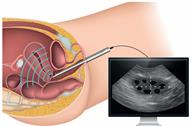Transvaginal Ultrasound
A transvaginal ultrasound, also called an endovaginal ultrasound, is a test that uses sound waves to take pictures of the female genital tract. The pictures are taken with a device, called a transducer, that is placed in the vagina.
This test may be done to:
Check for problems with your pregnancy.
Check your developing baby.
Check for anything abnormal in the uterus or ovaries.
Find out why you have pelvic pain or bleeding.
Tell a health care provider about:
-
Any allergies you have.
-
All medicines you are taking, including vitamins, herbs, eye drops, creams, and over-the-counter medicines.
-
Any bleeding problems you have.
-
Any surgeries you have had.
-
Any medical conditions you have.
-
Whether you are pregnant or may be pregnant.
-
Whether you are having your menstrual period.
What are the risks?
This is a safe procedure. There are no known risks or complications of having this test.
What happens before the procedure?
This procedure needs to be done when your bladder is empty. Follow your health care provider's instructions about drinking fluids and emptying your bladder before the test.
What happens during the procedure?

-
You will empty your bladder before the procedure.
-
You will undress from the waist down. You will put on a gown or a wrap to cover yourself while you get ready for the exam.
-
You will lie on your back on an exam table. You will place your feet into foot rests (stirrups). A drape will be placed over your abdomen and your legs.
-
A health care provider will cover the transducer with a germ-free (sterile) cover.
-
A gel will be put on the transducer. The gel helps transmit the sound waves and prevents irritation of your vagina.
-
The health care provider will insert the transducer into your vagina to get images. These will be displayed on a monitor that looks like a small television screen.
-
The transducer will be removed when the procedure is complete.
The procedure may vary among health care providers and hospitals.
What can I expect after the procedure?
-
It is up to you to get the results of your procedure. Ask your health care provider, or the department that is doing the procedure, when your results will be ready.
-
Keep all follow-up visits. This is important.
Summary
-
A transvaginal ultrasound, also called an endovaginal ultrasound, is a test that uses sound waves to take pictures of the female genital tract.
-
This is a safe procedure. There are no known risks associated with this test.
-
The procedure needs to be done when your bladder is empty. Follow your health care provider's instructions about drinking fluids and emptying your bladder before the test.
-
During the procedure, you will undress from the waist down and lie down on an exam table. A health care provider will insert a transducer into your vagina to obtain images.
-
Ask your health care provider, or the department that is doing the procedure, when your results will be ready.
This information is not intended to replace advice given to you by your health care provider. Make sure you discuss any questions you have with your health care provider.
